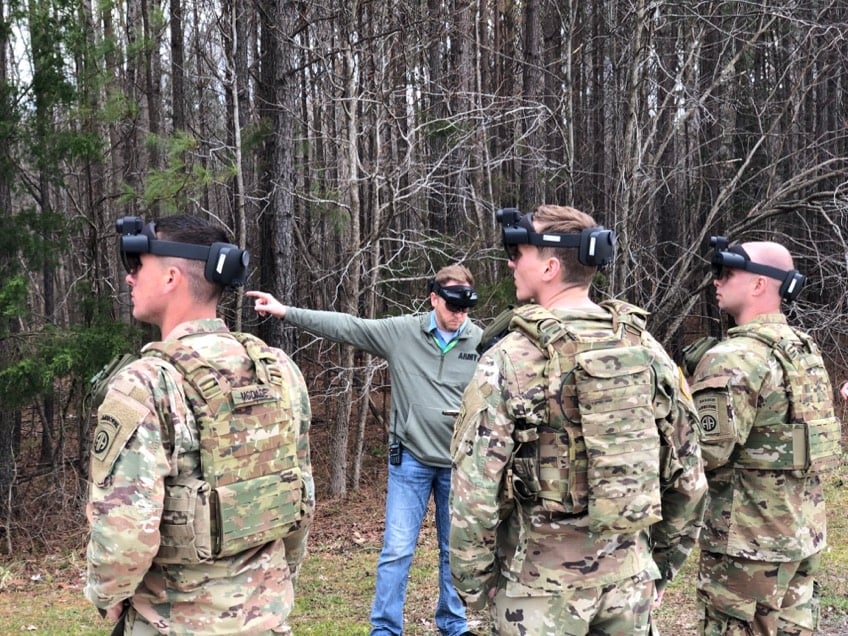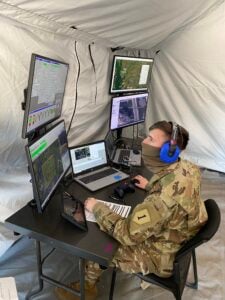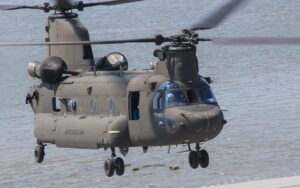
Soldiers train with the IVAS augmented-reality headset at Fort Pickett. A major IVAS field test this summer has been delayed until fall, but the program plans to make up the lost time.
WASHINGTON: The Army and its contractors are coping with the COVID-19 pandemic so well that the service expects no delay in the fielding of future weapons, the Army Secretary and his two top modernization officials told reporters today. The “rigorous” review of acquisition programs for the 2022 budget request is also still on schedule, Sec. Ryan McCarthy said.

Army Specialist Nicholas Miller wears a cloth mask as he remote-controls a new JUMP 20 drone during field tests.
“It’s just amazing how quickly they’ve adapted, kept their workforce engaged, and are protecting cost, schedule, and performance on these weapons systems,” said McCarthy, recently returned from a visit to BAE and General Dynamics facilities in Detroit. “Also I’m very proud of Dr. Jette’s and Gen. Murray’s performance during this crisis, working on things like progress payments for manufacturers, trying to help them get access to small business loans, the managing of second- and third-tier suppliers.”
“Right now, all the companies that were closed for any period of time are reopened,” said Assistant Secretary Bruce Jette, the service’s civilian acquisition chief. One BAE worker was infected, resulting in a week-long shutdown of a combat vehicle assembly line – you can’t weld armor plate over your telephone, Jette noted – but the company has now restarted production with new precautions in place. The company and the union have agreed to give up their traditional week-long shutdown for summer vacation to catch up.
The Boeing CH-47 helicopter plant in Philadelphia also shut down for 10 days, Jette reported, but they’re back up and running as well. He’s most worried about smaller subcontractors, where a single COVID-19 case can force the entire workforce to be quarantined for 14 days, so he’s tracking that closely.
“I keep track on a daily basis of 63 pages of supply chain [data],” Jette said. “Our industry partners have been really good about opening their books all the way down to their sub-suppliers and keeping us well-informed — they contractually don’t have to do that but they have.”

The latest variant of the Boeing Chinook, the CH-47F Block II, in test flight.
Some deliveries of prototypes have been delayed, said Gen. John “Mike” Murray, chief of Army Futures Command. But, so far, those delays are measured in weeks and there’s sufficient slack in schedules to catch up later this year, he said, which means programs will proceed to production and fielding on time.
What’s particularly tricky for the Army is that, after decades of dumping “good ideas” on soldiers only to find they didn’t actually work, it’s now systematically letting soldiers try out prototypes hands-on. These soldier touchpoints require troops to work together in the field, often side-by-side with contractors who record their feedback and make some fixes on the spot. That’s difficult given pandemic precautions – but not impossible.
Other types of testing allow a little more social distance, and work from engineering design to budget reviews can take place entirely online.
Gen. Murray gave a rundown of key programs:
- The next flight test of Lockheed Martin’s Precision Strike Missile (PrSM) will take place as scheduled on April 30th, Gen. Murray said. “I’m very confident,” he declared, to the point he’s already planned his flight to go observe.
- On the other hand, the third big soldier touchpoint test for the IVAS targeting goggles, scheduled for this summer, has been delayed to the fall. That’s not just because of social distancing, Murray said, but also because a Microsoft subcontractor ran into COVID-19 problems (they’ll be back in operation this week). Because this would have been the first test of a fully militarized and ruggedized “form factor” of IVAS, which began life as a modified Microsoft HoloLens, it’s too important to cut corners, he said. The program will be able to make up the lost time and deliver the final production version to troops on schedule, he said.
- There’s been a six week delay in delivery of the three competiting prototypes for Next Generation Squad Weapon, meant to replace the M249 SAW. Once the weapons arrive, however, the Army will now get them into soldiers’ hands in just two weeks, a month faster than originally planned, making up for most of that lost time.
- Field-testing of one contender for the new FTUAS drone is already underway at Fort Riley, as we’ve previously reported. Testing of another drone design at Fort Campbell is “a little bit delayed,” Murray said, but should start by the end of the month.
- The Limited User Test of the IBCS missile defense network has been postponed (again, as we’ve reported). But the equipment remains in place at White Sands Missile Range in New Mexico, Murray said, software updates continue, and the soldiers who spent months training to operate it will be back to do the test “this summer or early fall.”
(The Army also previously announced it would postpone field tests of promising new Robotic Combat Vehicles).
“In general,” Jette said, “we don’t see any FUEs changing”: That’s military jargon for “First Unit Equipped,” the crucial moment when enough of a weapon has been built to equip a significant combat unit.
“We are tracking each program,” Jette said, not just the service’s top priorities “but all of our over 600 programs, [and] none of them are at risk” of a delay so severe they can’t recover.
Army eyes TBI monitoring, wearable tech for soldiers in high-risk billets
“We are also looking at what additional personal protective equipment we can provide to our folks, especially instructors and others who are routinely exposed to blast pressure,” said Army Secretary Christine Wormuth.


























